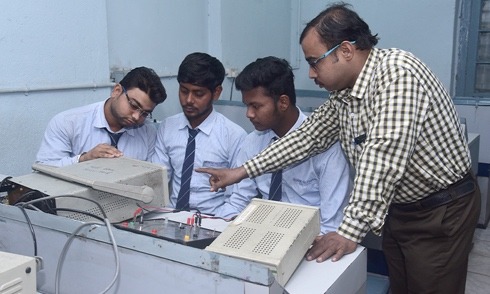#electronics and communication engineering
Text
Information Engineering and Information Technology are two distinct fields that have their differences. While both focus on the use of technology to better manage data and information, they each offer unique advantages in terms of implementation. Information Engineering focuses more on the development of software solutions while engineering in information technology is focused more on the management of those solutions. By understanding these distinctions, businesses can make thoughtful decisions when determining which field best fits their needs.
#juit#best private university in india#industrial training courses#b tech in bioinformatics#best institute in himachal pradesh#electronics and communication engineering#b tech in biotechnology#m.sc. in biotechnology#biotechnology colleges in himachal pradesh#privateengineering#degree#careers#Streams#B.Techcourse#education#colleges#student#student life#college life#studying#university#exams
3 notes
·
View notes
Text

Why Should You Choose ECE Over CSE?
Wondering why to choose Electronics and Communication Engineering (ECE) instead of Computer Science Engineering (CSE)? It’s all about the exciting stuff ECE lets you dive into. While both fields offer promising career paths, ECE holds a unique allure for those intrigued by the integration of hardware and software in the creation of communication systems.
0 notes
Text
The Subjects Of Electronics And Communication Engineering
It is a fundamental subject in Electronics and Communication Engineering colleges, as it allows them to design and optimize communication systems.

#electronics and communication engineering#electronics and communication engineering colleges in kolkata#electronics and communication courses#electronics and telecommunication engineering#electronics & telecommunication engineering
0 notes
Text

Short Course on Competitive Programming in Python
We are very glad to share that Department of Electronics and Communication Engineering SIRT, Bhopal is organizing a six-week Short Course on "Competitive Programming in Python" in association with IISER Bhopal.
Expert: Mr. Manav Mishra
PhD Research Scholar, Domain of Robotics and Automation
EECS Department at IISER Bhopal
Research Area: Multi-Agent Reinforcement Learning
#python#short term course#Electronics and Communication Engineering#ECE#best engineering college in bhopal#SIRT Bhopal
0 notes
Text
Career Scope of B.Tech Electronics and Communication Engineering - CGC Jhanjeri

Explore the "career scope of B.Tech Electronics and Communication Engineering" with abundant opportunities in research, development, and design fields. Join dynamic teams, revolutionizing communication technologies and robotics. Explore roles in telecommunication networks, satellite communication, and automation sectors. Your skills will drive advancements in wireless communication and embedded systems. Embrace a future of innovation, where your expertise impacts industries globally. Enroll now to unleash your potential and carve a successful career path. Don't miss this chance to be at the forefront of technological breakthroughs – seize the endless career scope of B.Tech in ECE today!
#Btech in ECE#Electronics and Communication Engineering#CGC Jhanjeri#Career Scope of Electronics field#best ece colleges in punjab#best ece colleges in Chandigarh#top ece colleges in Punjab#chandigarh group of colleges jhanjeri
1 note
·
View note
Text
Electronics and Communication Engineering: Innovate for a Better Tomorrow
Get the best in electronics and communication engineering from NIIT University. Our experienced faculty and state-of-the-art facilities provide students with the opportunity to excel in their chosen field.
0 notes
Text
74 th Republic Day Celebration at Quannta School of Software Engineering
On the 26 th of January 2023 the budding Engineers and the Sculptures of Quannta School of Software Engineering, wellknown for its academic excellence and state of an infrastructure for Computer Software Engineering Courses delivers exceptional brilliance in Computer Science Engineering as well as in Communication Engineering celebrated the National Festival in traditional and patriotic way with social responsibilities.
The students and faculties assembled in the college ground with delight and patriotic feel witnessing the grandeur arrangements made for celebrating the National Festival.Dr. K. Indira., Principal of Quannta School of Software Engineering welcomed the gathering and hoisted the Tri-Colored National Flag. The students and faculties took an oath of being responsible in socialcauses such as Energy Consumption,Water Consumption etc.
She briefed the importance of remembering the freedom fighters and the role of youths in making their dream come true.The management of Quannta School of Software Engineeringis a part of E.S Educational Group,which is one of the premier institute for advanced software engineering courses serving as one of the best colleges for software engineering in Villupuram District over 50+years had organized the grandeur celebration.
The Morning started with the enlightened speech by the students of Computer Science Engineering about the Role of Tamil Patriots in Freedom. The students of Electronics and Communication Engineering department steal the day by their speech on the Indian Freedom Fighters and their sacrifices for the Nation towards freedom.Various cultural activities were performed by the Electronics and Communication Engineering and Computer Science Engineering of Quannta School of Software Engineering. The winners of various events were awarded with goody’s.
The event ended with the National Anthem. The students pledged to do their part as a return to the farmers of our Nation. Lot of Positive Vibe is carried into the minds.
#School of Software Engineering#Computer Science Engineering#colleges for software engineering#Electronics and Communication Engineering
0 notes
Text
..*Greetings from Corizo !!!*
*The domains in which we offer internship programs, which might interest you are as follows:-*
*CSE/IT/ISE*
*MECH/AUTOMOBILE*
*EEE/ECE/E&TC*
*CIVIL/ARCHITECTURE*
*BCA/MCA*
*BBA/MBA*
*B.COM/M.COM*
*Psychology*
*Post completion rewards:-*
1. Internship Completion certificate. ( *With WIPRO Dice ID*)
2. Training completion certificate.
3. Outstanding Performer Certification based on the performance.
*Fill the form to grab the opportunity*
Form Link:-
https://forms.gle/amDrA4fuZpr4tk537
*TRAINING FEES APPLICABLE*
*Referral Code:- TF09*
(Kindly use referral code for discount)
*HAPPY LEARNING*💯...
#CORIZO#internship#computer science#information technology#electrical and electronics engineering#electrical and communication engineering#artificial intelligence
2 notes
·
View notes
Text
A collaborative group of researchers has potentially developed a means of controlling spin waves by creating a hexagonal pattern of copper disks on a magnetic insulator. The breakthrough is expected to lead to greater efficiency and miniaturization of communication devices in fields such as artificial intelligence and automation technology.
#nanotechnology#materialsscience#ai#electronics#engineering#communications#automation#scienceandtechnology
3 notes
·
View notes
Text
When choosing the right stream or field after Btech, it is important to evaluate your interests and passions, career goals, job market prospects, salary potential, and lifestyle preferences. Taking into consideration all of these factors will help you make an informed decision about which path to take in order to maximize your success. With a B.Tech degree under your belt, you can pursue any number of exciting and fulfilling careers! b. tech colleges in himachal pradesh.
#jaypeeuniversitysolan#privateengineering#degree#careers#Streams#b. tech colleges in himachal pradesh.#juit#jaypee#education#student#colleges#himachalpradesh#b tech in biotechnology#b tech in bioinformatics#biotechnology colleges in himachal pradesh#industrial training courses#best private university in india#best institute in himachal pradesh#electronics and communication engineering#college scholarship#college starters#college stress#college slam basketball#ayurveda nursing colleges in kerala#m.sc. in biotechnology#management#universities#career#ranking#course
0 notes
Text

Get The Best Electronics and Communication engineering Course in Kolkata
Are you looking for the best electronics training institute for your electronics and communication courses in Kolkata? then visit George Telegraph today and know your course fees details.
#electronics and communication engineering#electronics and communication engineering colleges in kolkata#electronics and communication courses#electronics and telecommunication engineering#electrical communication engineering#electronics & telecommunication engineering#be electronics and telecommunication#courses after diploma in electrical and electronics engineering#electronics course near me#electronics telecommunication engineering#electronics training courses#electronics training institute
0 notes
Text
Being both an electrical engineer and electronic musician is weird. I see the words "wave trap" and I think both about a device, used to protect power substations from power line communication high frequency carrier signals and a trap music subgenre.
#lightningstormstudies#electrical engineer#electrical engineering#music#musician#electronic music#electronic musician#engineering#engineer#power transmission#power lines#power substations#power system#power line communication#wave trap#line trap#wavetrap#wave#trap#weird#engblr#engineering student#engineering studyblr#electricity#electrical engineering student#random thoughts#reflection#studyblr#high voltage#it's weird
9 notes
·
View notes
Text
“If buying isn’t owning, piracy isn’t stealing”

20 years ago, I got in a (friendly) public spat with Chris Anderson, who was then the editor in chief of Wired. I'd publicly noted my disappointment with glowing Wired reviews of DRM-encumbered digital devices, prompting Anderson to call me unrealistic for expecting the magazine to condemn gadgets for their DRM:
https://longtail.typepad.com/the_long_tail/2004/12/is_drm_evil.html
I replied in public, telling him that he'd misunderstood. This wasn't an issue of ideological purity – it was about good reviewing practice. Wired was telling readers to buy a product because it had features x, y and z, but at any time in the future, without warning, without recourse, the vendor could switch off any of those features:
https://memex.craphound.com/2004/12/29/cory-responds-to-wired-editor-on-drm/
I proposed that all Wired endorsements for DRM-encumbered products should come with this disclaimer:
WARNING: THIS DEVICE’S FEATURES ARE SUBJECT TO REVOCATION WITHOUT NOTICE, ACCORDING TO TERMS SET OUT IN SECRET NEGOTIATIONS. YOUR INVESTMENT IS CONTINGENT ON THE GOODWILL OF THE WORLD’S MOST PARANOID, TECHNOPHOBIC ENTERTAINMENT EXECS. THIS DEVICE AND DEVICES LIKE IT ARE TYPICALLY USED TO CHARGE YOU FOR THINGS YOU USED TO GET FOR FREE — BE SURE TO FACTOR IN THE PRICE OF BUYING ALL YOUR MEDIA OVER AND OVER AGAIN. AT NO TIME IN HISTORY HAS ANY ENTERTAINMENT COMPANY GOTTEN A SWEET DEAL LIKE THIS FROM THE ELECTRONICS PEOPLE, BUT THIS TIME THEY’RE GETTING A TOTAL WALK. HERE, PUT THIS IN YOUR MOUTH, IT’LL MUFFLE YOUR WHIMPERS.
Wired didn't take me up on this suggestion.
But I was right. The ability to change features, prices, and availability of things you've already paid for is a powerful temptation to corporations. Inkjet printers were always a sleazy business, but once these printers got directly connected to the internet, companies like HP started pushing out "security updates" that modified your printer to make it reject the third-party ink you'd paid for:
https://www.eff.org/deeplinks/2020/11/ink-stained-wretches-battle-soul-digital-freedom-taking-place-inside-your-printer
Now, this scam wouldn't work if you could just put things back the way they were before the "update," which is where the DRM comes in. A thicket of IP laws make reverse-engineering DRM-encumbered products into a felony. Combine always-on network access with indiscriminate criminalization of user modification, and the enshittification will follow, as surely as night follows day.
This is the root of all the right to repair shenanigans. Sure, companies withhold access to diagnostic codes and parts, but codes can be extracted and parts can be cloned. The real teeth in blocking repair comes from the law, not the tech. The company that makes McDonald's wildly unreliable McFlurry machines makes a fortune charging franchisees to fix these eternally broken appliances. When a third party threatened this racket by reverse-engineering the DRM that blocked independent repair, they got buried in legal threats:
https://pluralistic.net/2021/04/20/euthanize-rentier-enablers/#cold-war
Everybody loves this racket. In Poland, a team of security researchers at the OhMyHack conference just presented their teardown of the anti-repair features in NEWAG Impuls locomotives. NEWAG boobytrapped their trains to try and detect if they've been independently serviced, and to respond to any unauthorized repairs by bricking themselves:
https://mamot.fr/@[email protected]/111528162905209453
Poland is part of the EU, meaning that they are required to uphold the provisions of the 2001 EU Copyright Directive, including Article 6, which bans this kind of reverse-engineering. The researchers are planning to present their work again at the Chaos Communications Congress in Hamburg this month – Germany is also a party to the EUCD. The threat to researchers from presenting this work is real – but so is the threat to conferences that host them:
https://www.cnet.com/tech/services-and-software/researchers-face-legal-threats-over-sdmi-hack/
20 years ago, Chris Anderson told me that it was unrealistic to expect tech companies to refuse demands for DRM from the entertainment companies whose media they hoped to play. My argument – then and now – was that any tech company that sells you a gadget that can have its features revoked is defrauding you. You're paying for x, y and z – and if they are contractually required to remove x and y on demand, they are selling you something that you can't rely on, without making that clear to you.
But it's worse than that. When a tech company designs a device for remote, irreversible, nonconsensual downgrades, they invite both external and internal parties to demand those downgrades. Like Pavel Chekov says, a phaser on the bridge in Act I is going to go off by Act III. Selling a product that can be remotely, irreversibly, nonconsensually downgraded inevitably results in the worst person at the product-planning meeting proposing to do so. The fact that there are no penalties for doing so makes it impossible for the better people in that meeting to win the ensuing argument, leading to the moral injury of seeing a product you care about reduced to a pile of shit:
https://pluralistic.net/2023/11/25/moral-injury/#enshittification
But even if everyone at that table is a swell egg who wouldn't dream of enshittifying the product, the existence of a remote, irreversible, nonconsensual downgrade feature makes the product vulnerable to external actors who will demand that it be used. Back in 2022, Adobe informed its customers that it had lost its deal to include Pantone colors in Photoshop, Illustrator and other "software as a service" packages. As a result, users would now have to start paying a monthly fee to see their own, completed images. Fail to pay the fee and all the Pantone-coded pixels in your artwork would just show up as black:
https://pluralistic.net/2022/10/28/fade-to-black/#trust-the-process
Adobe blamed this on Pantone, and there was lots of speculation about what had happened. Had Pantone jacked up its price to Adobe, so Adobe passed the price on to its users in the hopes of embarrassing Pantone? Who knows? Who can know? That's the point: you invested in Photoshop, you spent money and time creating images with it, but you have no way to know whether or how you'll be able to access those images in the future. Those terms can change at any time, and if you don't like it, you can go fuck yourself.
These companies are all run by CEOs who got their MBAs at Darth Vader University, where the first lesson is "I have altered the deal, pray I don't alter it further." Adobe chose to design its software so it would be vulnerable to this kind of demand, and then its customers paid for that choice. Sure, Pantone are dicks, but this is Adobe's fault. They stuck a KICK ME sign to your back, and Pantone obliged.
This keeps happening and it's gonna keep happening. Last week, Playstation owners who'd bought (or "bought") Warner TV shows got messages telling them that Warner had walked away from its deal to sell videos through the Playstation store, and so all the videos they'd paid for were going to be deleted forever. They wouldn't even get refunds (to be clear, refunds would also be bullshit – when I was a bookseller, I didn't get to break into your house and steal the books I'd sold you, not even if I left some cash on your kitchen table).
Sure, Warner is an unbelievably shitty company run by the single most guillotineable executive in all of Southern California, the loathsome David Zaslav, who oversaw the merger of Warner with Discovery. Zaslav is the creep who figured out that he could make more money cancelling completed movies and TV shows and taking a tax writeoff than he stood to make by releasing them:
https://aftermath.site/there-is-no-piracy-without-ownership
Imagine putting years of your life into making a program – showing up on set at 5AM and leaving your kids to get their own breakfast, performing stunts that could maim or kill you, working 16-hour days during the acute phase of the covid pandemic and driving home in the night, only to have this absolute turd of a man delete the program before anyone could see it, forever, to get a minor tax advantage. Talk about moral injury!
But without Sony's complicity in designing a remote, irreversible, nonconsensual downgrade feature into the Playstation, Zaslav's war on art and creative workers would be limited to material that hadn't been released yet. Thanks to Sony's awful choices, David Zaslav can break into your house, steal your movies – and he doesn't even have to leave a twenty on your kitchen table.
The point here – the point I made 20 years ago to Chris Anderson – is that this is the foreseeable, inevitable result of designing devices for remote, irreversible, nonconsensual downgrades. Anyone who was paying attention should have figured that out in the GW Bush administration. Anyone who does this today? Absolute flaming garbage.
Sure, Zaslav deserves to be staked out over an anthill and slathered in high-fructose corn syrup. But save the next anthill for the Sony exec who shipped a product that would let Zaslav come into your home and rob you. That piece of shit knew what they were doing and they did it anyway. Fuck them. Sideways. With a brick.
Meanwhile, the studios keep making the case for stealing movies rather than paying for them. As Tyler James Hill wrote: "If buying isn't owning, piracy isn't stealing":
https://bsky.app/profile/tylerjameshill.bsky.social/post/3kflw2lvam42n

If you'd like an essay-formatted version of this post to read or share, here's a link to it on pluralistic.net, my surveillance-free, ad-free, tracker-free blog:
https://pluralistic.net/2023/12/08/playstationed/#tyler-james-hill

Image:
Alan Levine (modified)
https://pxhere.com/en/photo/218986
CC BY 2.0
https://creativecommons.org/licenses/by/2.0/
#pluralistic#playstation#sony#copyright#copyfight#drm#monopoly#enshittification#batgirl#road runner#financiazation#the end of ownership#ip
23K notes
·
View notes
Text
Admission Btech in Electronics and Communication Engineering - CGC Jhanjeri

Admission to B.Tech in Electronics and Communication Engineering program offers a gateway to a dynamic and promising field. Students explore a wide array of topics, including digital electronics, communication systems, microprocessors, and signal processing. The curriculum emphasizes practical knowledge through laboratory work and projects, honing skills in circuit design and communication technologies. This program prepares graduates for various industries, such as telecommunications, semiconductor, and electronics manufacturing. Additionally, students delve into cutting-edge areas like wireless communication, embedded systems, and IoT. Pursuing B.Tech in Electronics and Communication Engineering opens doors to a rewarding career, contributing to advancements in global communication and technology-driven solutions.
#Admission to B.Tech in Electronics and Communication Engineering#Btech in ECE#Electronics and Communication Engineering#cgc jhanjeri#chandigarh group of colleges#colleges for btech#best colleges for btech in chandigarh
0 notes
Text
MIT conductive concrete consortium cements five-year research agreement with Japanese industry
New Post has been published on https://thedigitalinsider.com/mit-conductive-concrete-consortium-cements-five-year-research-agreement-with-japanese-industry/
MIT conductive concrete consortium cements five-year research agreement with Japanese industry
The MIT Electron-conductive Cement-based Materials Hub (EC^3 Hub), an outgrowth of the MIT Concrete Sustainability Hub (CSHub), has been established by a five-year sponsored research agreement with the Aizawa Concrete Corp. In particular, the EC^3 Hub will investigate the infrastructure applications of multifunctional concrete — concrete having capacities beyond serving as a structural element, such as functioning as a “battery” for renewable energy.
Enabled by the MIT Industrial Liaison Program, the newly formed EC^3 Hub represents a large industry-academia collaboration between the MIT CSHub, researchers across MIT, and a Japanese industry consortium led by Aizawa Concrete, a leader in the more sustainable development of concrete structures, which is funding the effort.
Under this agreement, the EC^3 Hub will focus on two key areas of research: developing self-heating pavement systems and energy storage solutions for sustainable infrastructure systems. “It is an honor for Aizawa Concrete to be associated with the scaling up of this transformational technology from MIT labs to the industrial scale,” says Aizawa Concrete CEO Yoshihiro Aizawa. “This is a project we believe will have a fundamental impact not only on the decarbonization of the industry, but on our societies at large.”
By running current through carbon black-doped concrete pavements, the EC^3 Hub’s technology could allow cities and municipalities to de-ice road and sidewalk surfaces at scale, improving safety for drivers and pedestrians in icy conditions. The potential for concrete to store energy from renewable sources — a topic widely covered by news outlets — could allow concrete to serve as a “battery” for technologies such as solar, wind, and tidal power generation, which cannot produce a consistent amount of energy (for example, when a cloudy day inhibits a solar panel’s output). Due to the scarcity of the ingredients used in many batteries, such as lithium-ion cells, this technology offers an alternative for renewable energy storage at scale.
Carbon black doped concrete pavements can have current run through them to heat their surfaces, allowing for de-icing. If implemented for city roads and sidewalks, this technology could have benefits for pedestrian and vehicular safety.
Photo courtesy of the MIT EC^3 Hub and Aizawa Concrete.
Previous item
Next item
Professor Admir Masic, EC^3 Hub’s founding faculty director, demonstrates the self-heating capability of carbon black doped concrete pavements with a laser thermometer, showing the difference between the pavement surface temperature and the ambient temperature.
Photo courtesy of the MIT EC^3 Hub and Aizawa Concrete.
Previous item
Next item
A charged carbon-cement supercapacitor powers multiple LED lights and is connected to a multimeter to measure the system’s voltage at 12 volts.
Photo courtesy of the MIT EC^3 Hub and Aizawa Concrete.
Previous item
Next item
Regarding the collaborative research agreement, the EC^3 Hub’s founding faculty director, Professor Admir Masic, notes that “this is the type of investment in our new conductive cement-based materials technology which will propel it from our lab bench onto the infrastructure market.” Masic is also an associate professor in the MIT Department of Civil and Environmental Engineering, as well as a principal investigator within the MIT CSHub, among other appointments.
For the April 11 signing of the agreement, Masic was joined in Fukushima, Japan, by MIT colleagues Franz-Josef Ulm, a professor of Civil and Environmental Engineering and faculty director of the MIT CSHub; Yang Shao-Horn, the JR East Professor of Engineering, professor of mechanical engineering, and professor of materials science and engineering; and Jewan Bae, director of MIT Corporate Relations. Ulm and Masic will co-direct the EC^3 Hub.
The EC^3 Hub envisions a close collaboration between MIT engineers and scientists as well as the Aizawa-led Japanese industry consortium for the development of breakthrough innovations for multifunctional infrastructure systems. In addition to higher-strength materials, these systems may be implemented for a variety of novel functions such as roads capable of charging electric vehicles as they drive along them.
Members of the EC^3 Hub will engage with the active stakeholder community within the MIT CSHub to accelerate the industry’s transition to carbon neutrality. The EC^3 Hub will also open opportunities for the MIT community to engage with the large infrastructure industry sector for decarbonization through innovation.
#agreement#ambient#applications#batteries#battery#carbon#Cells#cement#CEO#cities#Civil and environmental engineering#Cleaner industry#Collaboration#collaborative#Community#concrete#Concrete Sustainability Hub#decarbonization#development#Difference Between#DMSE#Electric motors#electric vehicles#electron#energy#energy storage#engineering#engineers#Environmental#Faculty
0 notes